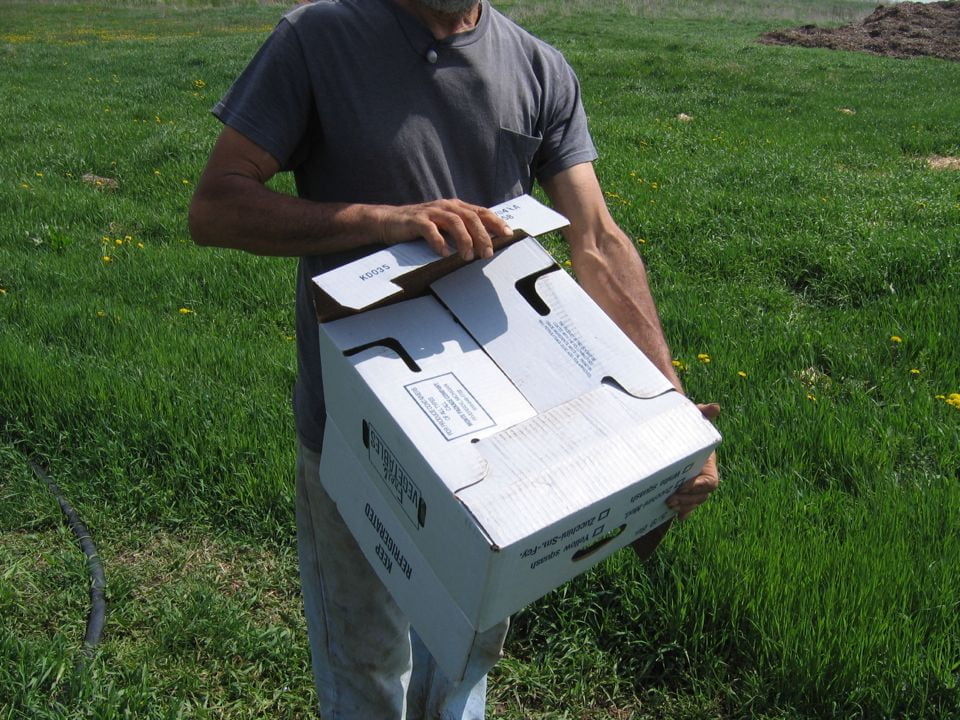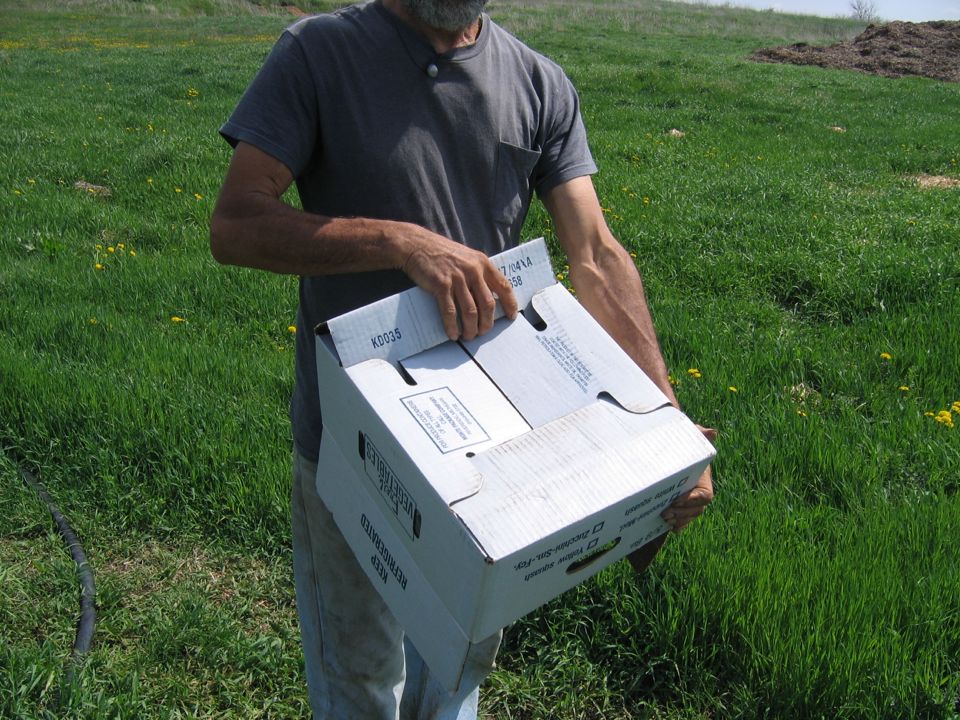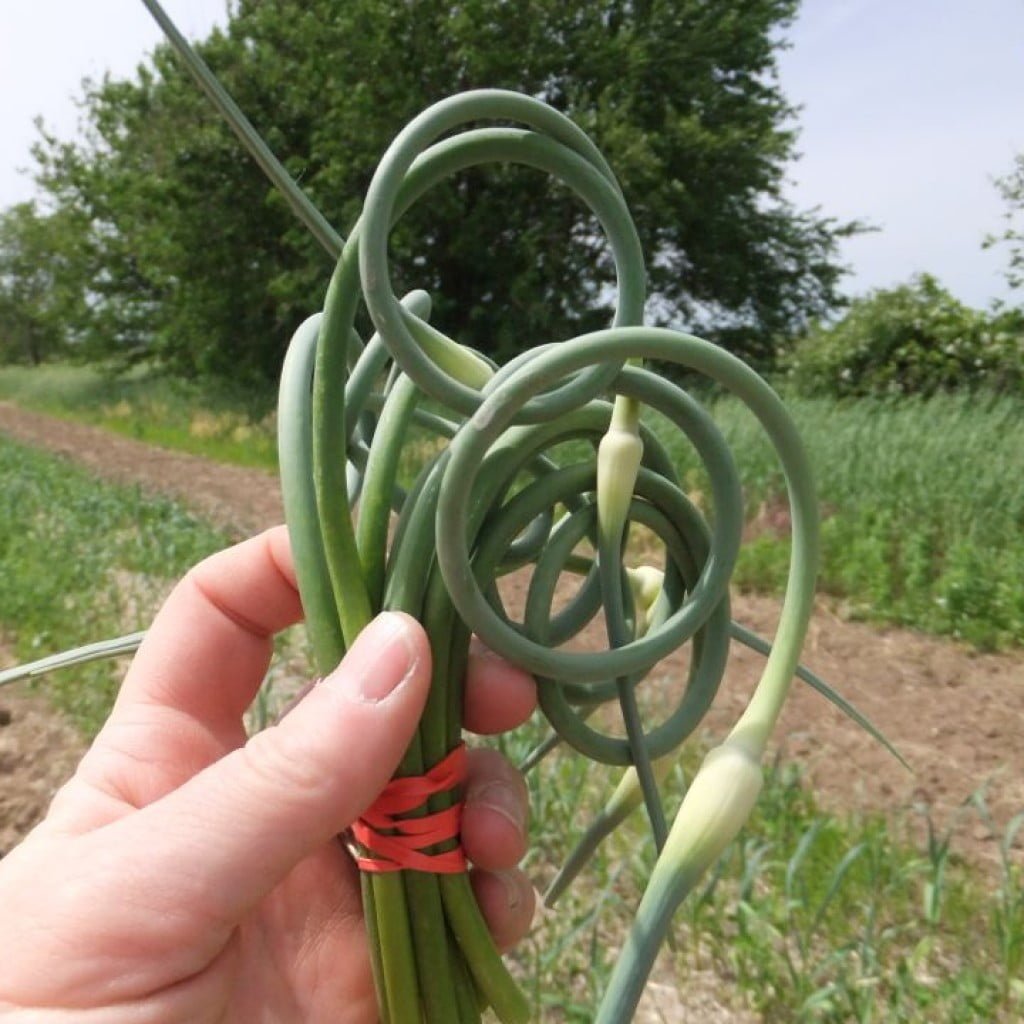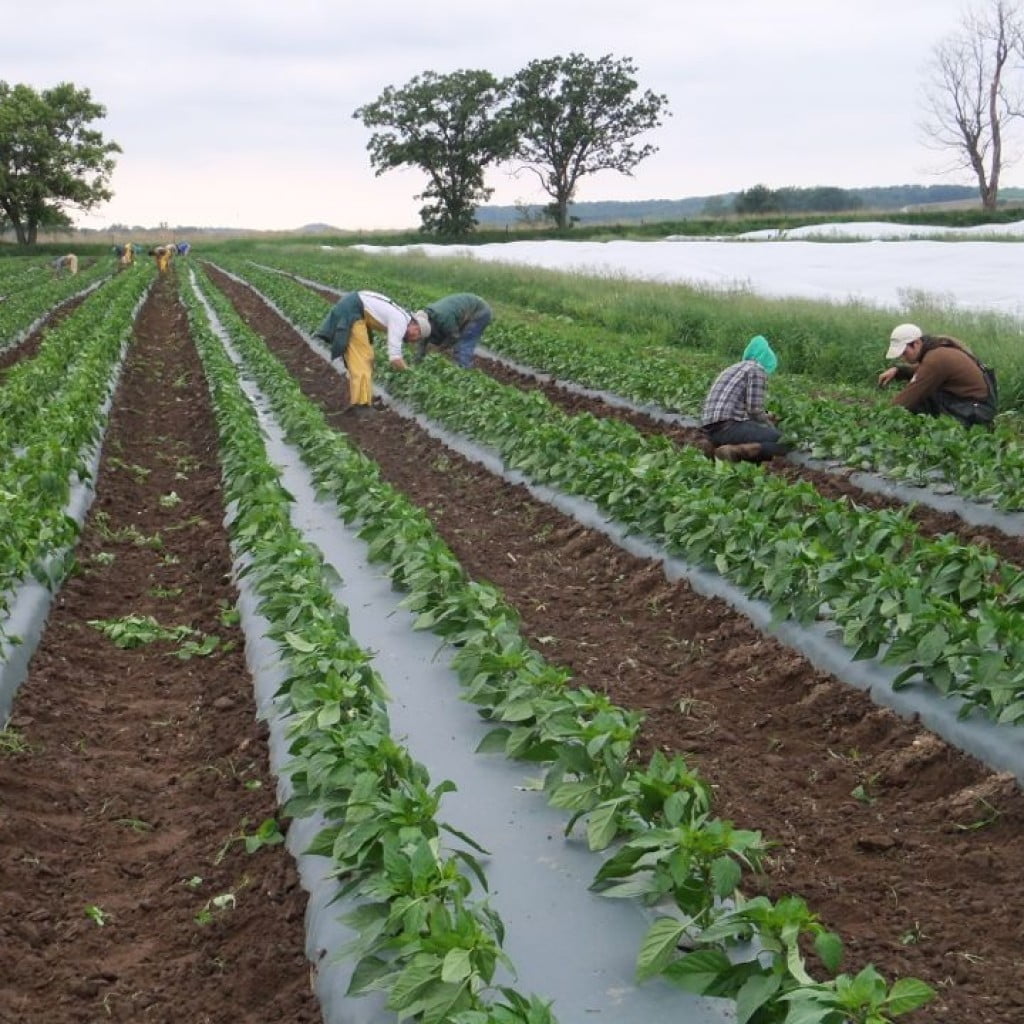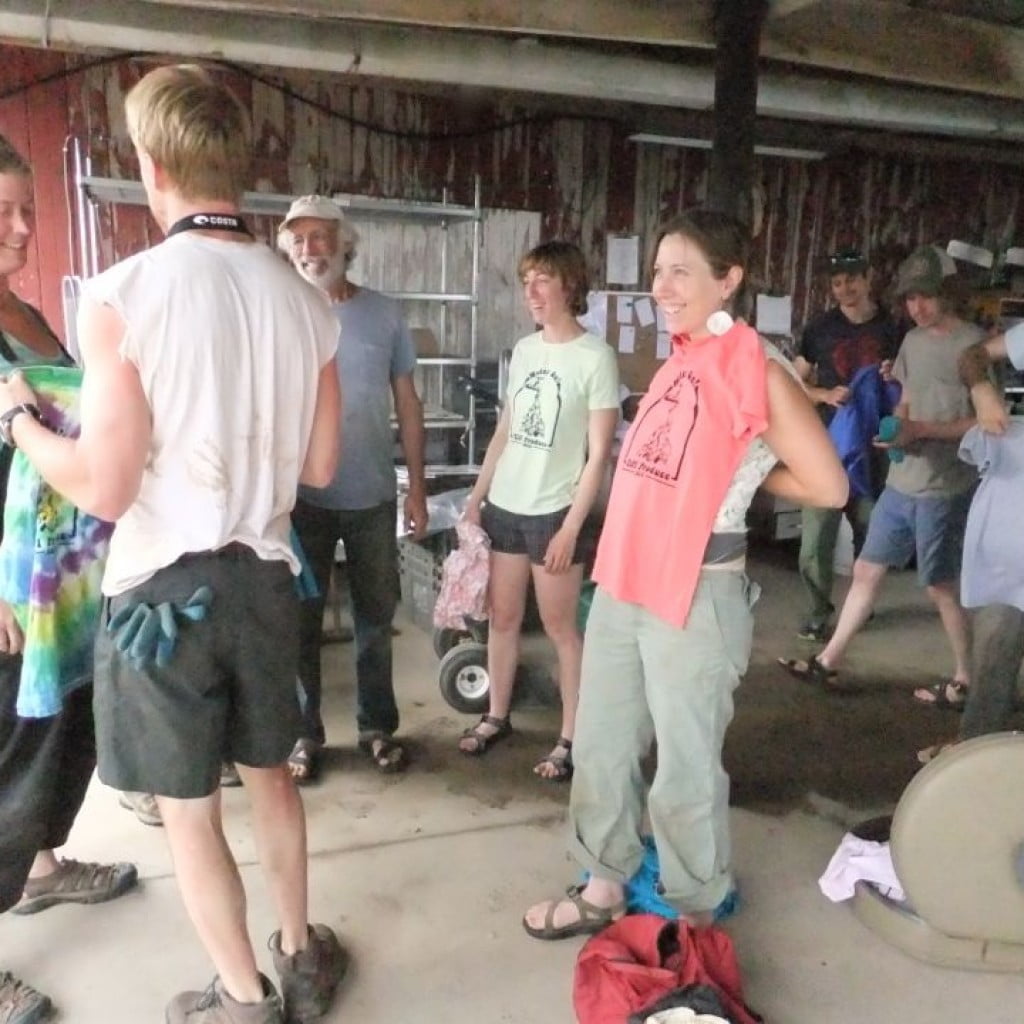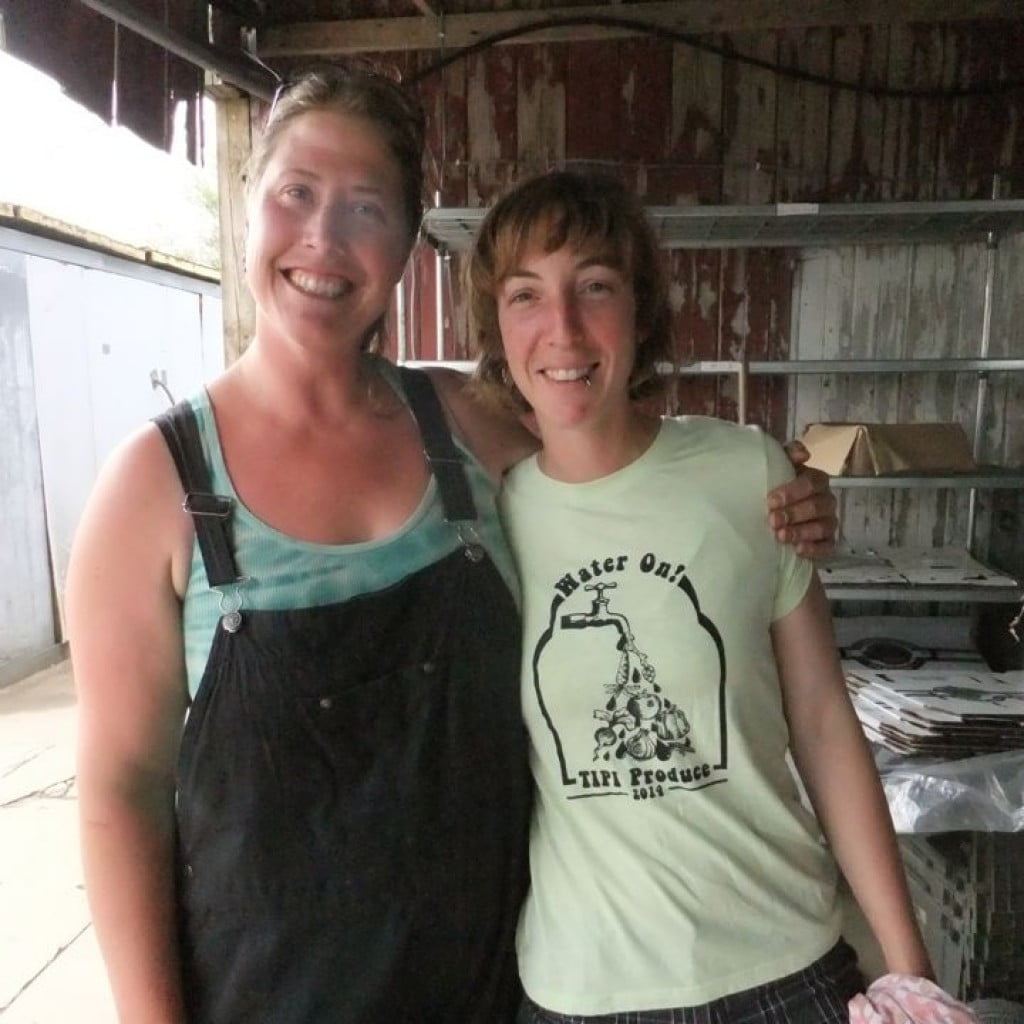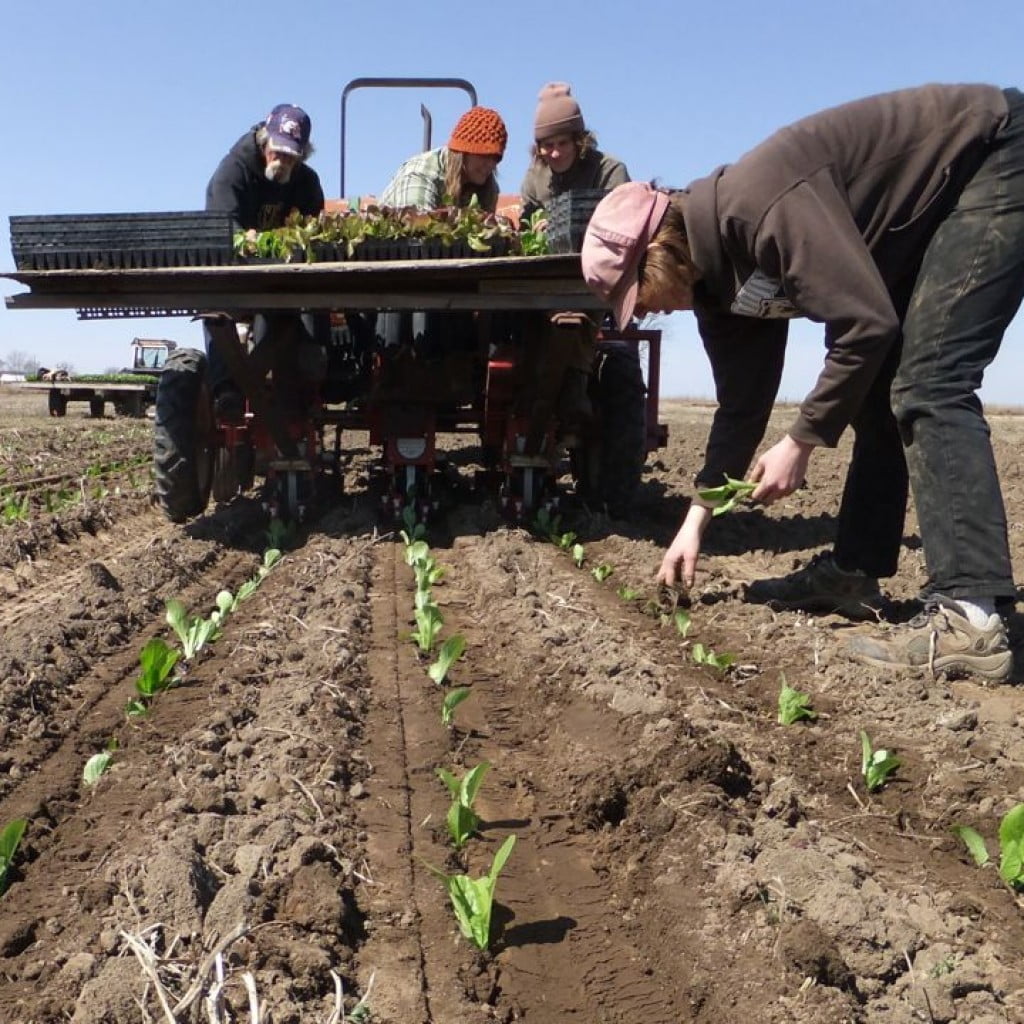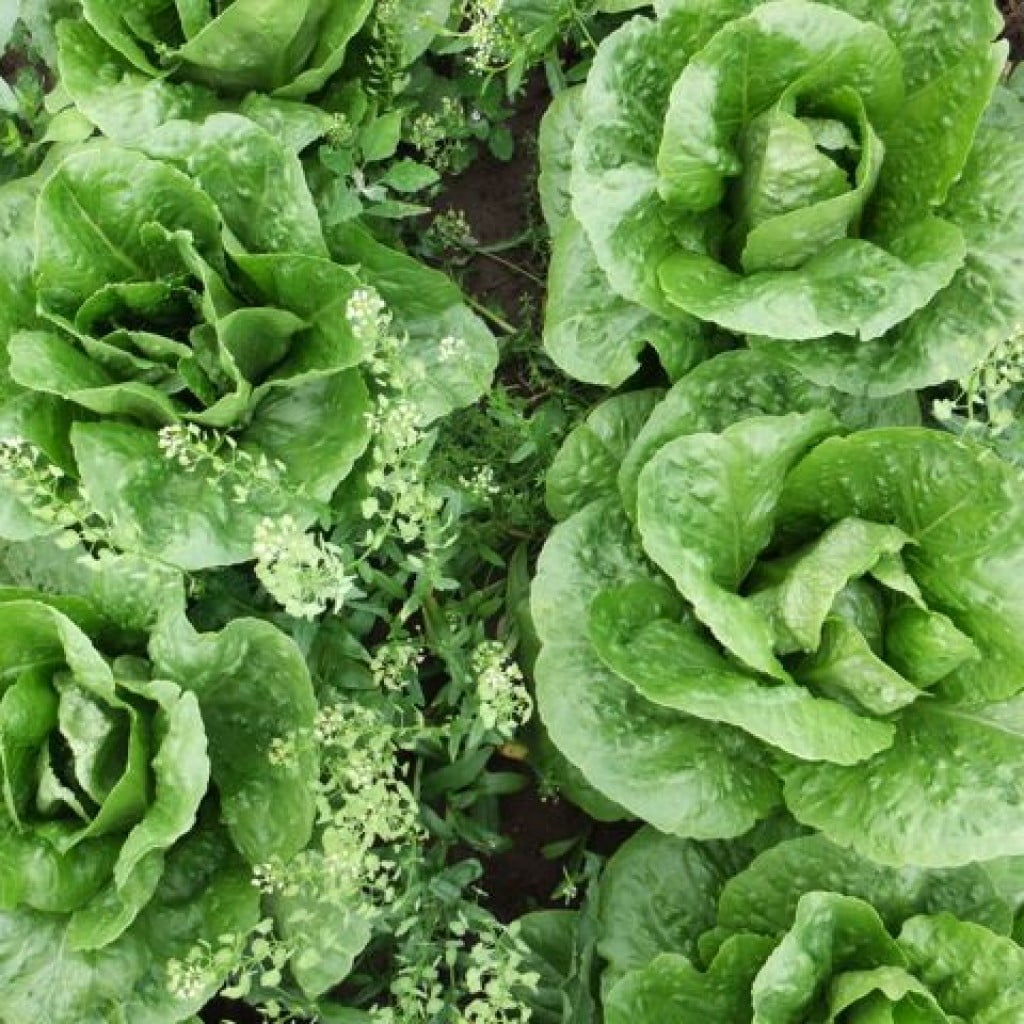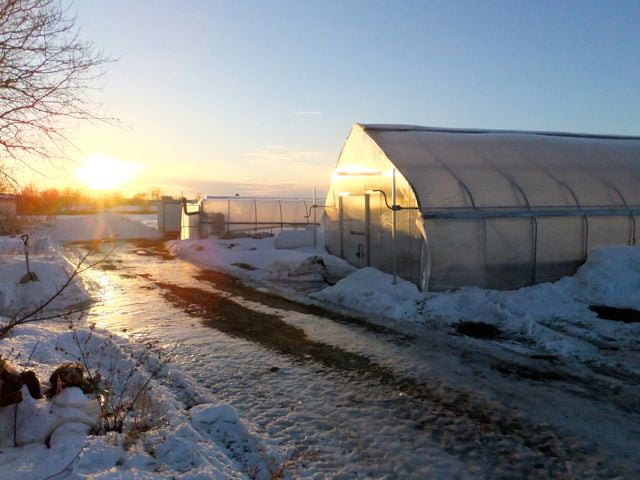Yearly Archives: 2014
What do farmers do during rainy weather?
- On: July 02, 2014
 0
0
It’s been too wet for field work this week. We harvest your veggies rain-or-shine, but can’t take tractors in the fields when the ground is too muddy. Steve spent his time buying more irrigation pipe. How ironic is that, to work on irrigation during a monsoon? We will enjoy the new pipe; it will allow us to irrigate five big carrot fields (over 3 acres) at once without moving pipe. This is a big improvement. Of course, the carrots are not planted yet because the ground is too wet.

Steve with our new irrigation pipe.
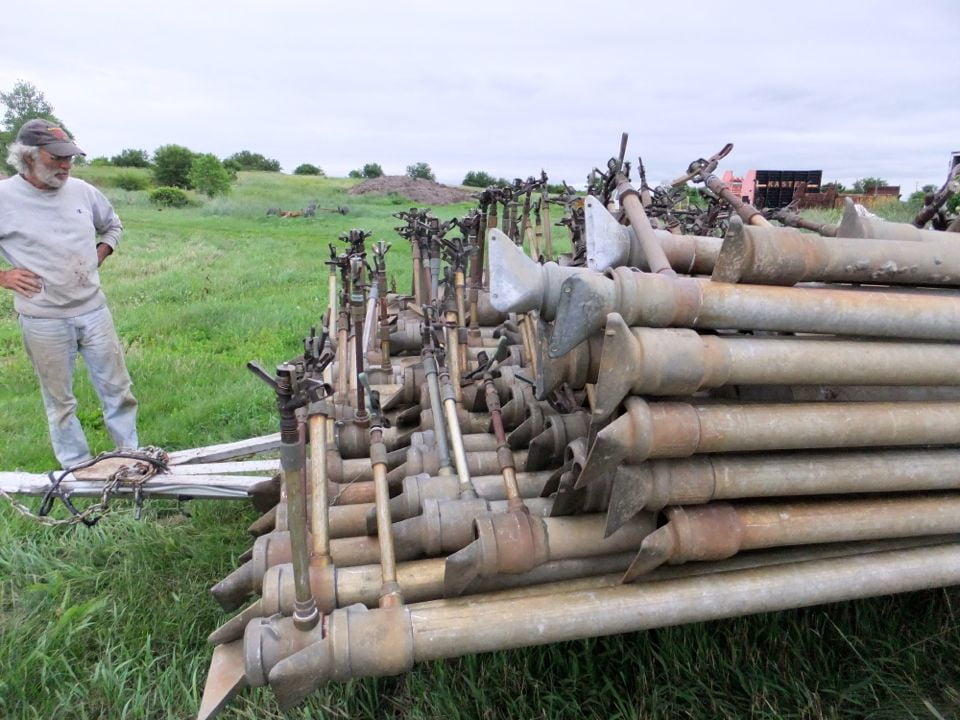
The business end of the pipe although, as Steve says, “it’s really good to have both ends.”
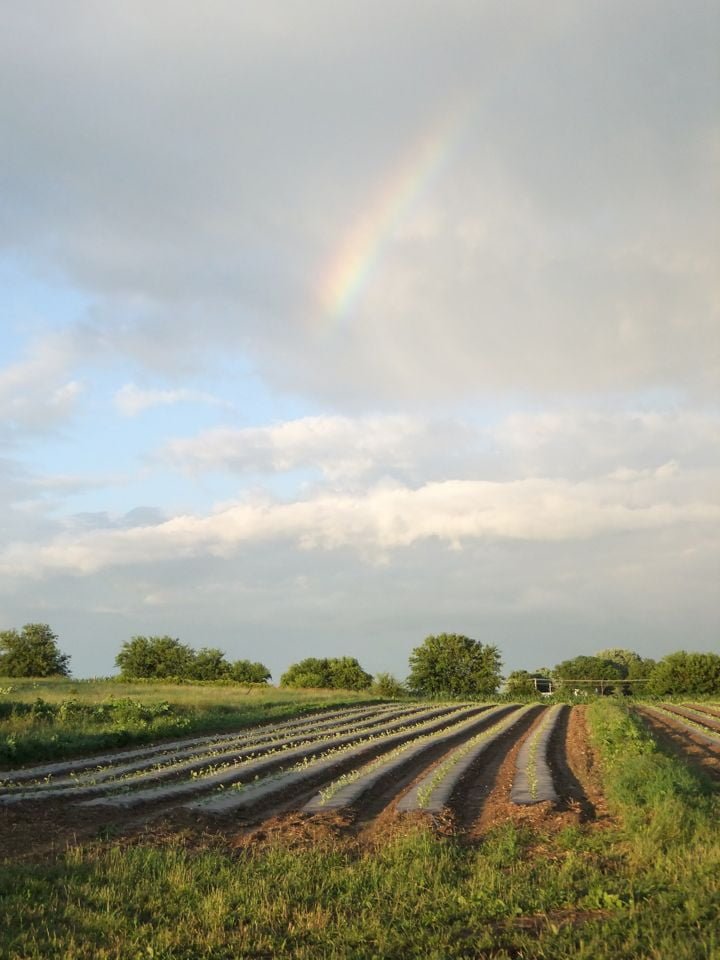
A sunny moment between rain storms.
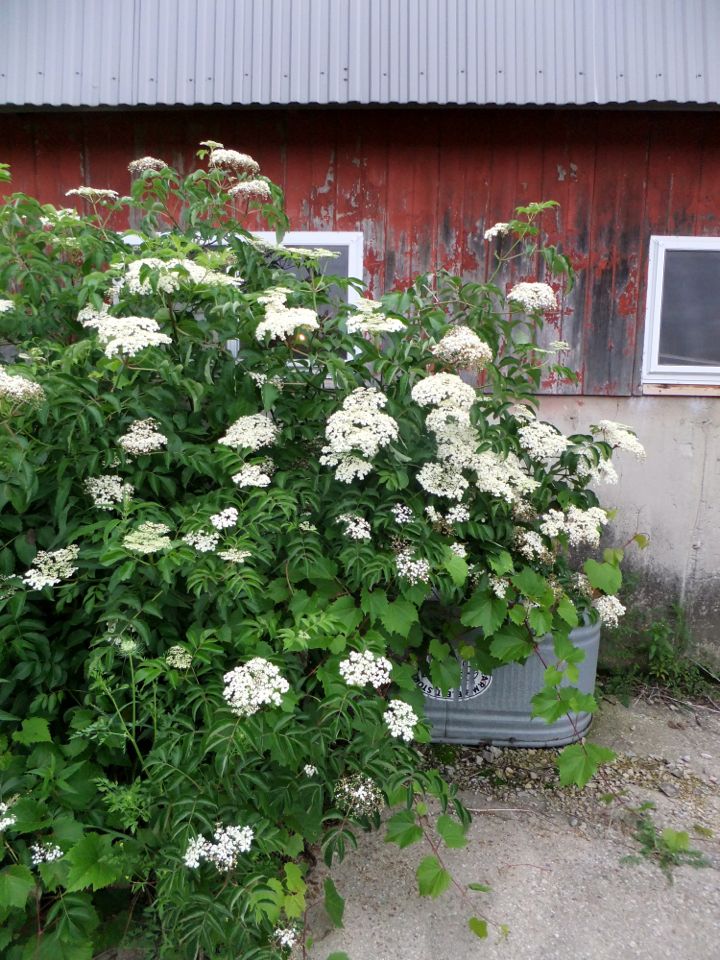
The elderberry bushes are spectacular this year.
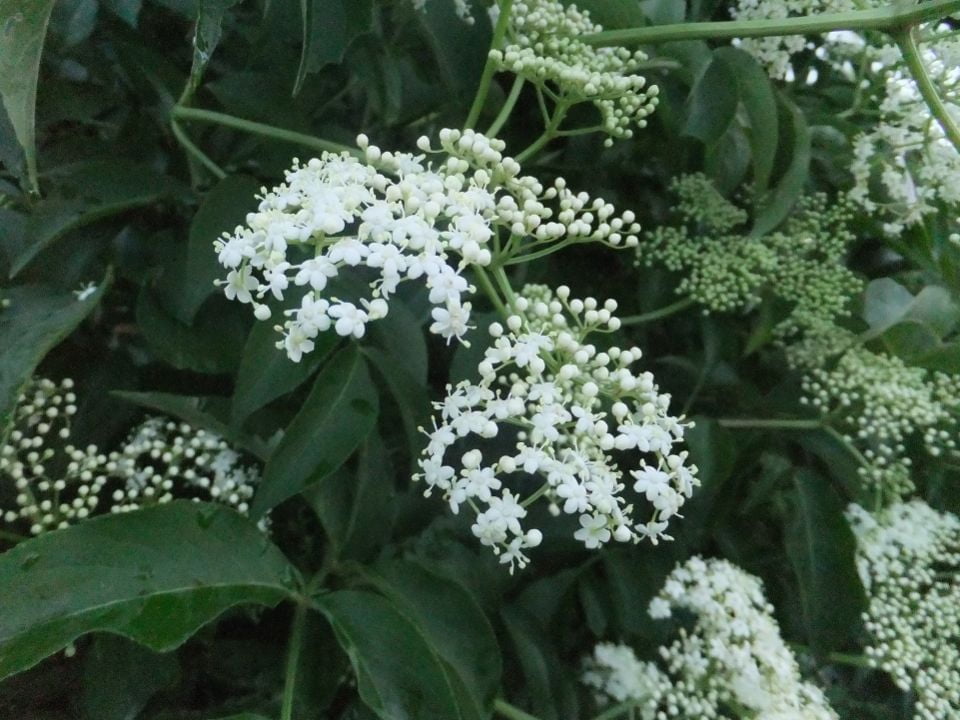
Every bride should carry lacy elderberry blossoms, never mind the funky smell.
Veggie List and Veggie Notes (week #7, green EOW)
We enjoyed the strawberry u-pick on Sunday. Lots of members came to pick berries and wander the farm. Fortunately, the u-pick berries ripened during somewhat drier weather. Sadly, pounding rainstorms on Sunday night and Monday damaged the late berries. That ends our strawberry season.
We’ve sent a lot of squash and cucumbers because the plants were remarkably productive this week. Our bees did not visit (or pollinate) our squash plants for a long time because of rainy or windy weather. Once the plants got pollinated during dry spells, they exploded with rapid squash growth. Same thing happened with the cucumbers. Grilled squash and cucumber salad are great 4th of July dishes. Enjoy!
Snap peas, 1.4 lb
Broccoli, 1 head
Zucchini & summer squash, 3 – 3.5 lb
Cucumbers, 4
Collard greens, 1 bunch
Green leaf lettuce, 1 small
Kohlrabi, 1
Scallions, 1 large bunch
Basil, 1 sprig
Next week’s box will probably contain cabbage, zucchini, fennel, parsley, cucumbers, lettuce, scallions OR Walla Walla onions, and more.
Basil (curly-leaved sprig) – This is the variety ‘Napoletano.’ The leaves are larger and more frilly than most basils. We like this variety because the its leaves remain tender and flavorful even as the plants mature. Basil will blacken if stored in the refrigerator. It is best stored at room temperature with the cut ends in water, for example in a glass or teacup. Give the stem a fresh trim. You will receive one sturdy stem this week. We snipped these sprigs to shape the plants. They are a bit tattered from the recent rains but taste (and smell) great.
Green leaf lettuce – The lettuce are quite small. We harvested them young while they are still good. It’s a good strategy during wet or hot weather.
We grabbed our opportunity.
- On: June 25, 2014
 0
0
The recent rains have slowed our farm work. Even pollination is slow; bees don’t leave their hives in rainy weather. No bee visits to the zucchini blossoms = no zucchini. There was a break in the weather today, a chance to catch up on our stalled field work. The soil was just dry enough today for transplanting.
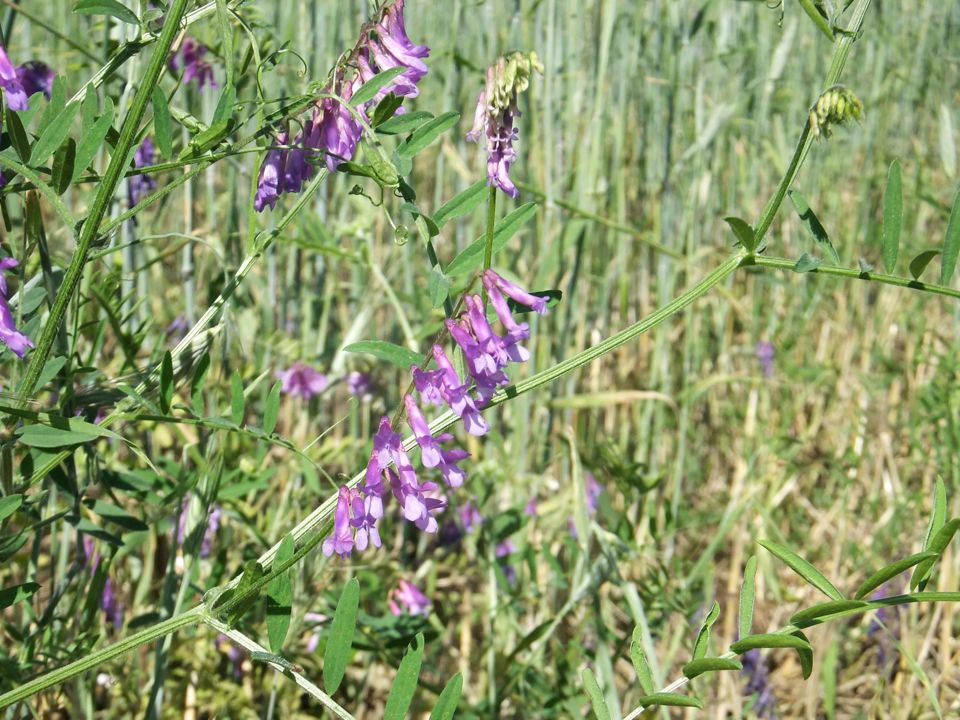
We mowed this hairy vetch cover crop weeks ago but it’s been too wet to till into the ground. Now it’s regrown and flowered again. We need to mow a second time, till, then let the soil rest so we can plant carrots in early July.
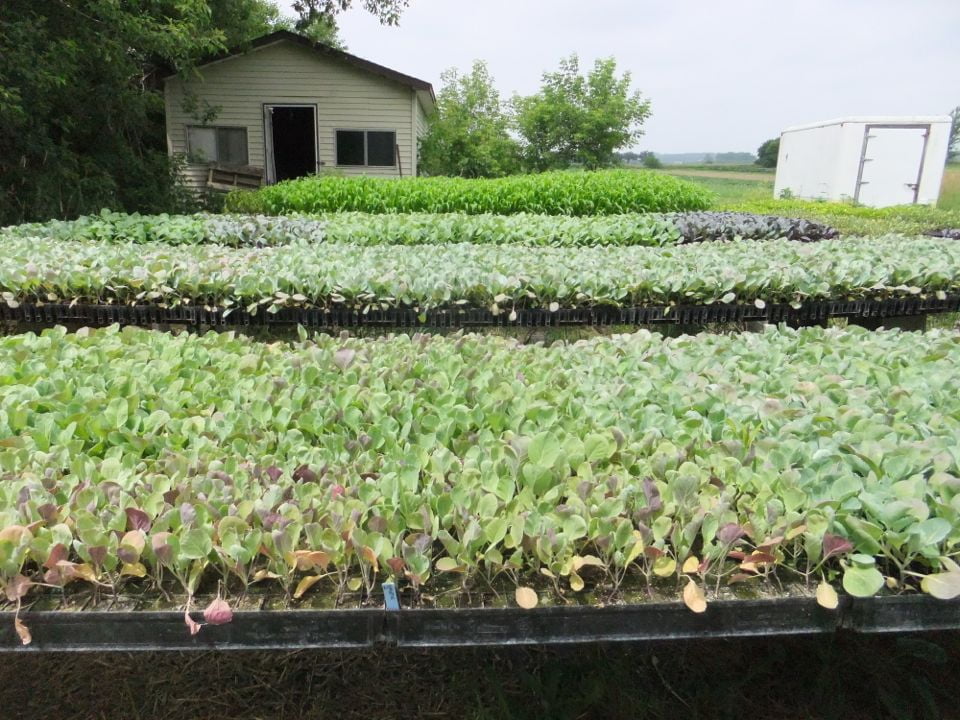
These seedlings are desperate to be planted in the ground.
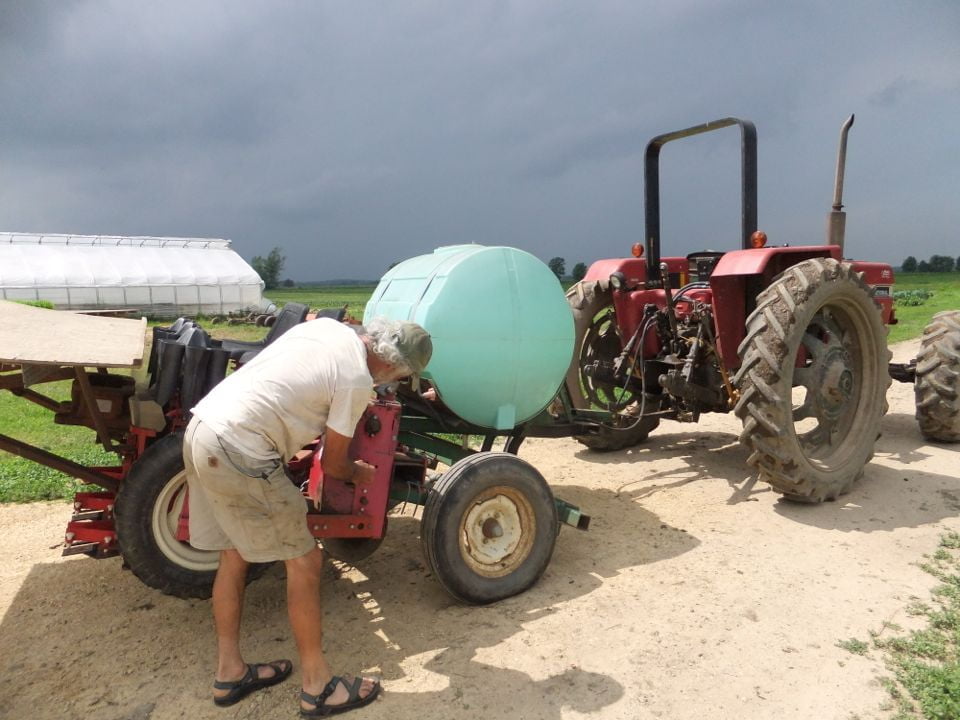
Steve prepped the transplanter as a storm approached.
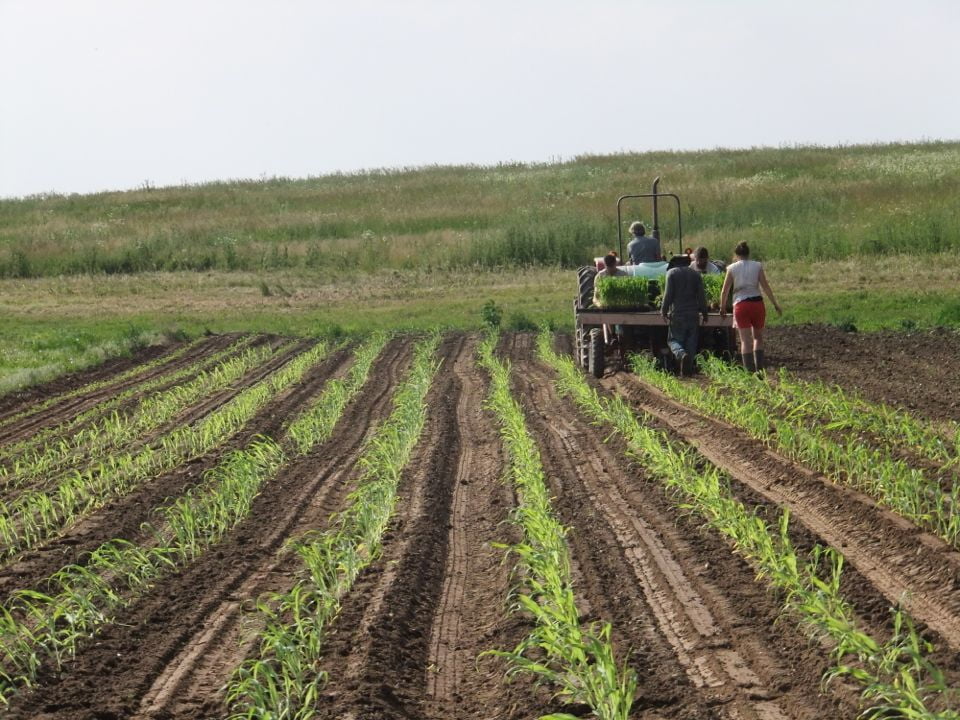
The main storm missed us, sliding by to the west. We waited out a 20 minute shower, then the sun returned. The crew got the next sweet corn planting in the ground. We will all reap the reward in August.
Strawberry U-Pick
See our emails for details of our next berry picking.
How to flatten your CSA box.
Let’s review how to flatten your empty CSA box. We need to re-use these expensive boxes many times, but find that many boxes are getting ripped. It’s a skill to learn! Please watch Steve’s demonstration in this YouTube video. Thank you for your help with this.
- Hold the box at waist height, with the bottom of the box facing up.
- The first step is to loosen the two shorter flaps.
- Grasp the edge of the short flap closest to you and PULL TOWARD YOURSELF. The flap will bend at its natural crease.
- Do not PULL UP on the flap or the tabs will rip, ruining the box.
- The flap can now be pulled loose.
- Repeat with the other short flap.
- Unfold the two long flaps.
- Repeat for the top of the box if it is closed.
- Now collapse the box so it is flat. Please stack neatly with the other empty CSA boxes.
- Thank you!
Veggie List and Veggie Notes (6/26/14, week #6, purple EOW)
You should eat your strawberries right away. They are very juicy because of all the rain, and might spoil quickly. The rain didn’t affect any of the other veggies that we’re delivering this week.
Strawberries, 1 quart + 1 pint
Asparagus, 0.6 lb
Mixed zucchini and summer squash, about 2 lb
Snap peas, 0.75 lb
Snow peas, 0.25 lb
(The snap and snow peas are combined in one bag.)
Lacinato kale OR Napa cabbage (You will receive one of these)
Daikon radishes, 2 or 3
Rhubarb, 1.5 lb
Scallions, 1 large bunch
Garlic scapes
Next week’s box will probably contain strawberries, peas, lettuce, zucchini, cucumbers, broccoli, basil and more.
Strawberries – Eat these right away.
Zucchini and summer squash – This is the first picking, just in time for the official start of summer. The first squash are often oddly shaped, as the bees haven’t settled into pollinating them thoroughly.
Snap peas have plump pods and snow peas are flatter. You need to remove the strings from both types. See instructions in last week’s newsletter.
Lacinato kale (bunch of ruffled dark green leaves) – This is a popular kale, also known as ‘dinosaur kale.’
Napa cabbage (a pale green head of soft-leaved cabbage) – This Asian vegetable can be eaten raw in salads, or cooked in simple stir-fries. Napa stores very well. Cut off wedges as needed and keep the rest covered and refrigerated, and it will keep for several weeks. Peel off the outer layer and it will be ready to use. Here are a few preparation ideas from the ‘Asparagus to Zucchini’ cookbook.
– Chop raw napa into green salads.
– Substitute napa in traditional coleslaw.
– Chinese cabbage cooks quickly. Steam 3-5 minutes, or until leaves are wilted down but remain slightly crisp.
– Substitute napa cabbage for common cabbage in recipes, but reduce the cooking time by 2 minutes.
– Napa cabbage is the main ingredient in egg rolls. Try making an egg roll mixture to eat as a cooked side dish instead of preparing time-consuming egg rolls.
Daikon radish (slender white roots) – These Asian radishes are good cooked or raw. We often make a sliced radish salad, with Asian-style dressing (rice vinegar, mirin, sesame oil, soy sauce, minced garlic). Even a brief marination mellows the radish’s sharpness.
Next steps
- On: June 18, 2014
 0
0
Let’s review our CSA delivery schedule for the week of July 4.
That’s the next green EOW delivery.
– Evansville, Madison, Middleton and Oregon deliveries will be on Thursday, July 3, as expected.
– Milwaukee area and Janesville deliveries will be on Thursday July 3 to avoid the July 4 holiday.
Strawberry U-Picks
Please read our emails for info about upcoming strawberry u-picks here at the farm.
Food Preservation Volunteers Needed at the Goodman Center in Madison
Tipi member Amy Mach coordinates this program, which allows you to learn new skills or put your current preservation skills to good use. Amy writes “Help preserve nature’s bounty as a volunteer in the Goodman Community Center’s food preservation program. No experience necessary! The Community Center is located on the eastside of Madison. The produce you preserve will fill the shelves of the Fritz food pantry with healthy local food. Last year, volunteers in this important program were able to can, dehydrate and freeze 3,000 pounds of local fruits and vegetables, helping to feed the 100+ families per week that our food pantry supports year-round. Enjoy a flexible schedule of one 3-4 hour shift per week. Choose between daytime, evening and weekend opportunities that fit your calendar!”
Attend one of their informational sessions. Each session is 2 hours long and includes new volunteer orientation.
June 19th at 3pm
June 30th at 5pm
Please RSVP to Amy Mach, amymach(at)goodmancenter.org or 608.241.1574 x227
Farm Progress
The tornados and severe storms missed our farm this week. I hope all of you are faring OK, and the storms missed you too.
We uncovered our zucchini and cucumber fields last week. We keep the plants under floating row cover in early spring to protect them from frost and to speed their growth. Of course, weeds also grow faster under row cover. They’re a cover crop as long as they don’t set seed, right? We tackled the weeds on Monday before the big storms. The squash plants are uncovered, the bees can pollinate the blossoms, and we’ll have squash for you next week. Beth
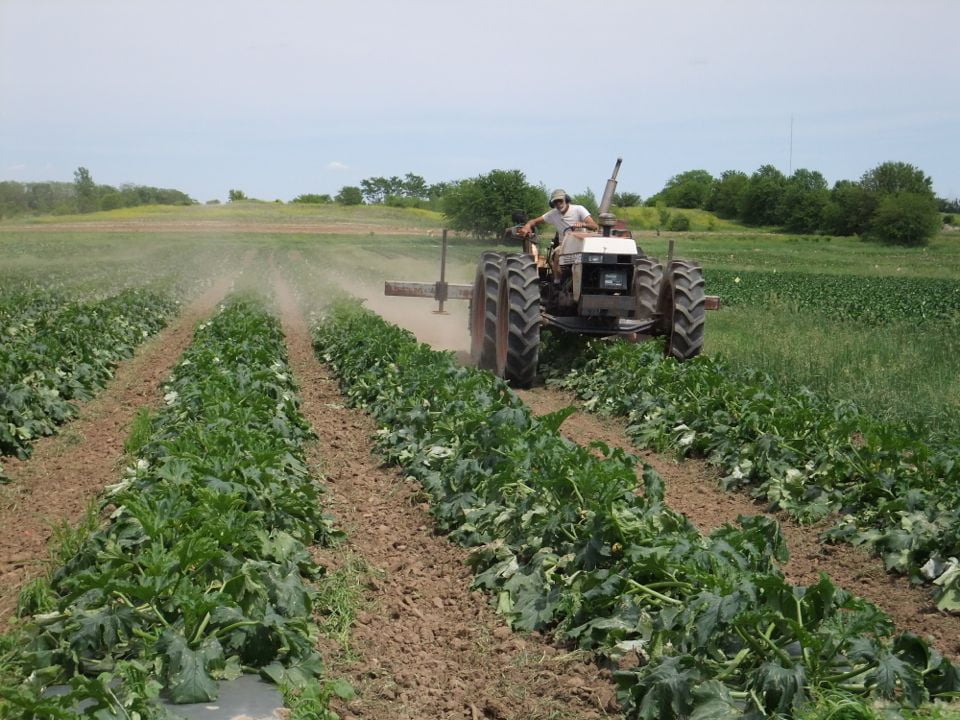
Steve cultivates the zucchini field. He moves along quickly. Steve and Michael were cultivating at the same time on Monday, a race to get the work done while the fields were still dry.
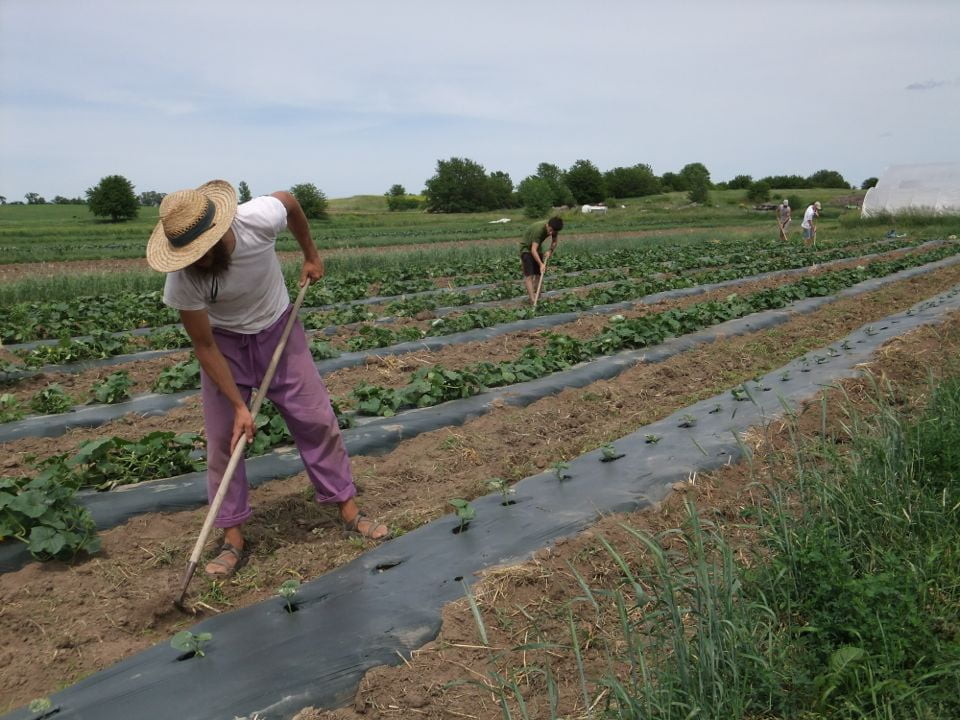
Clint, Peter and others follow up with hoes in the cucumber field. The tractor gets most weeds but never all of them.
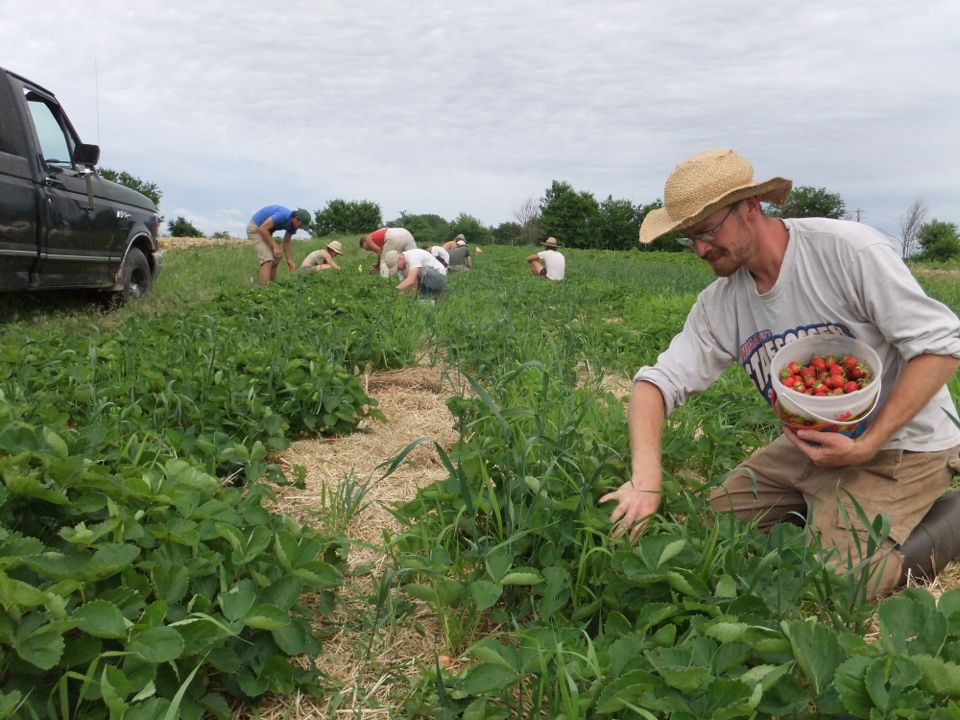
Billy (and others) pick your strawberries.
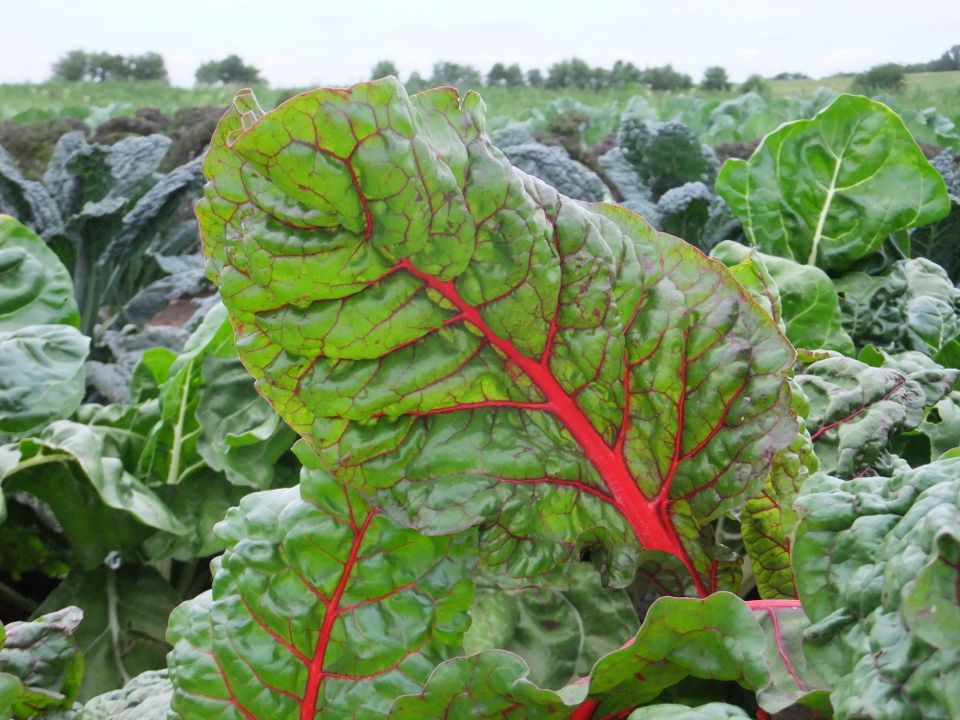
Red Swiss chard. Steve plants rows of red, pink, yellow and white chard next to each other so we can easily make colorful bunches. This is its natural color, not Photoshopped.
Veggie List and Veggie Notes (6/19/2014, week #5, green EOW)
Strawberries, 1 quart or 2 pints
Asparagus, 1 lb
Snap peas, 1 lb
Snow peas, 1/4 lb
(The snap and snow peas are combined in one bag.)
Swiss chard, 1 medium bunch
Green leaf lettuce, 1
Green cabbage, 1, about 2 to 2.5 lb
Scallions, 1 large bunch
Garlic scapes
Next week’s box will probably contain strawberries, zucchini or summer squash, peas, napa cabbage, daikon radish, scallions, garlic scapes, rhubarb and more.
Strawberries! We’ve been waiting for these.
♦ Strawberries are perishable. Ripe berries should be eaten immediately, or stored in the refrigerator. Most berries are quite clean. If you want to clean your berries, rinse gently. Don’t soak them, just rinse. Do not be concerned if you receive a partially-filled container. Sometimes we fill them partially in order to distribute berries to all the members.
♦ Please recycle your strawberry containers this year. We no longer collect them for re-use.
Snap peas (plump pea pods) – These peas should be eaten pod and all. They are delicious raw, or very lightly cooked or stir-fried. They might need a quick rinse to remove faded gray blossoms. Store in the refrigerator. Here’s how to remove the strings from the snap peas. Snap off the stem end and pull the string down the concave side of the pod (the inward-curing side). Throw away the string and eat the pod.
Snow peas (flat pea pods) – These are excellent stir fried or in raw salads. The thicker pea pods will usually have two strings along the edges. Remove them when you snap the stem off.
Swiss chard (pretty bundle of greens with mixed-color stems) – This is a close relative of spinach, but requires a bit more cooking. Use as a substitute in any recipe that calls for spinach, just cook the chard a little longer. Both stems and leaves are delicious. The stems requite longer cooking, so cut them free from the leaves when preparing. That allows you to cook the stems longer.
Cabbage – This ia a nice salad-type that we grow in summer. Don’t you love the pointy shape? It has thinner, more tender leaves than the usual green cabbage. Great in salads and slaws but can also be cooked. Most of this week’s cabbage weigh between 2 and 2.5 lb.
Garlic scapes (curly green things) – Garlic scapes grow at the top of garlic plants. They look like flower buds but are actually clusters of tiny bulblets. It’s important to snap off the young scapes to direct the plants’ energy into forming garlic bulbs underground. Use scapes as a substitute for garlic cloves. They can be minced, mixed with olive oil, and added to stir fries or simple pasta dishes. The scapes can be sautéed, but will not brown like garlic cloves. Expect them to retain their crunch even when cooked, and to be milder than garlic cloves, closer in pungency to the green garlic we’ve sent.
Most of the scapes are from John Hendrickson of Stone Circle Farm who grows organic garlic for our CSA. We planted a small field of garlic last fall, providing more scapes.
Empty greenhouses, full fields
- On: June 11, 2014
 0
0
We finished an intense burst of field work last week. Under threat of coming rain, Steve and the crew rushed to transplant our seedlings into the field. We emptied two full greenhouses, a total of 50,000 plants. Everyone worked so hard. We have reviewed and practiced our hand signals this spring for communication with our tractor drivers. For example, we circle a finger in the air to say “speed up.” Simone looked back from the tractor during pepper transplanting. Clint was planting so quickly with both hands that he couldn’t even manage the hand signal, just a big grin and a nod of the head. Sturdy pepper seedlings can handle that kind of speed. We slow down for melons and cucumbers because their roots are fragile and they need gentle handling. Handle them roughly during transplanting and many plants will die.
Steve reviewed the accomplishments at the end of the week, thanked everyone, and announced “Of course, all of those fields will need weeding in 10 days.” That was a sobering moment. Fortunately, the work goes quickly with a large group of people. I asked Steve why we were able to complete so much in one week. He said it was the cohesive crew, terrific plants, cooperative weather. Personally, I think it was the new t-shirts.
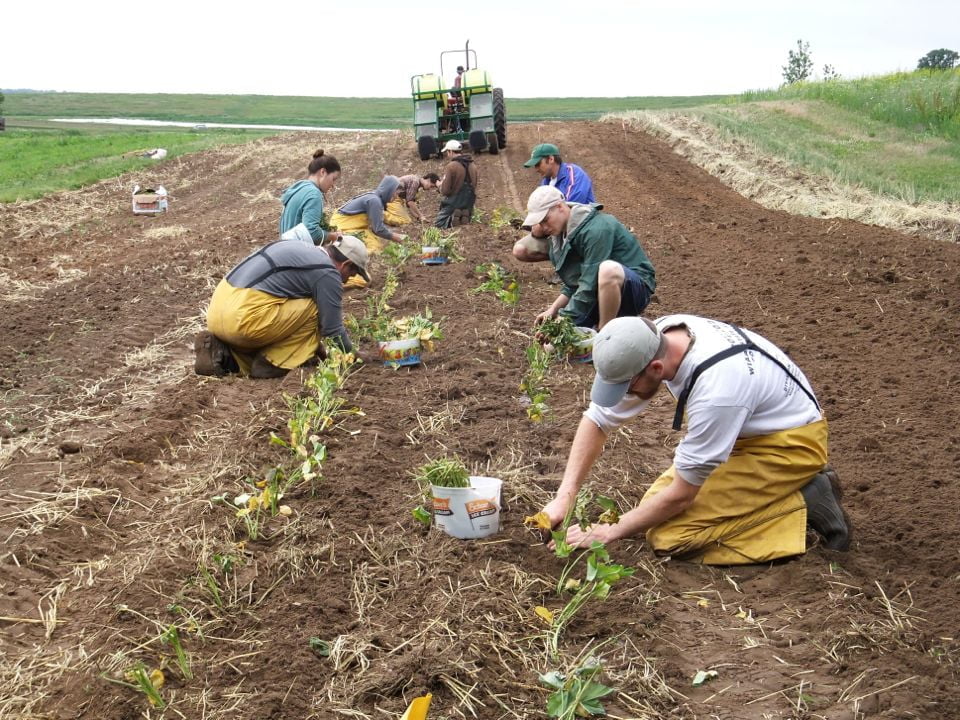
See what we can accomplish as a group? Planting sweet potato slips.
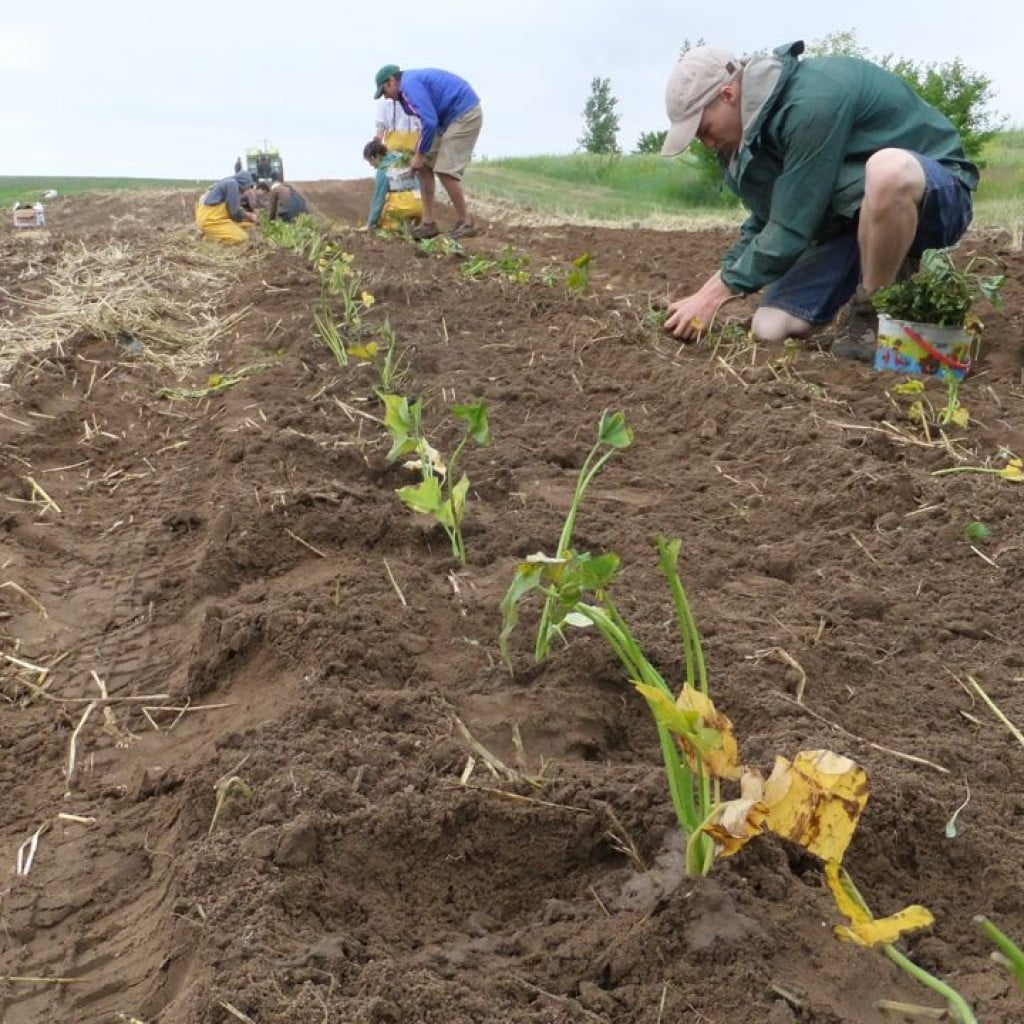
These tiny cuttings will grow into ten foot vines.
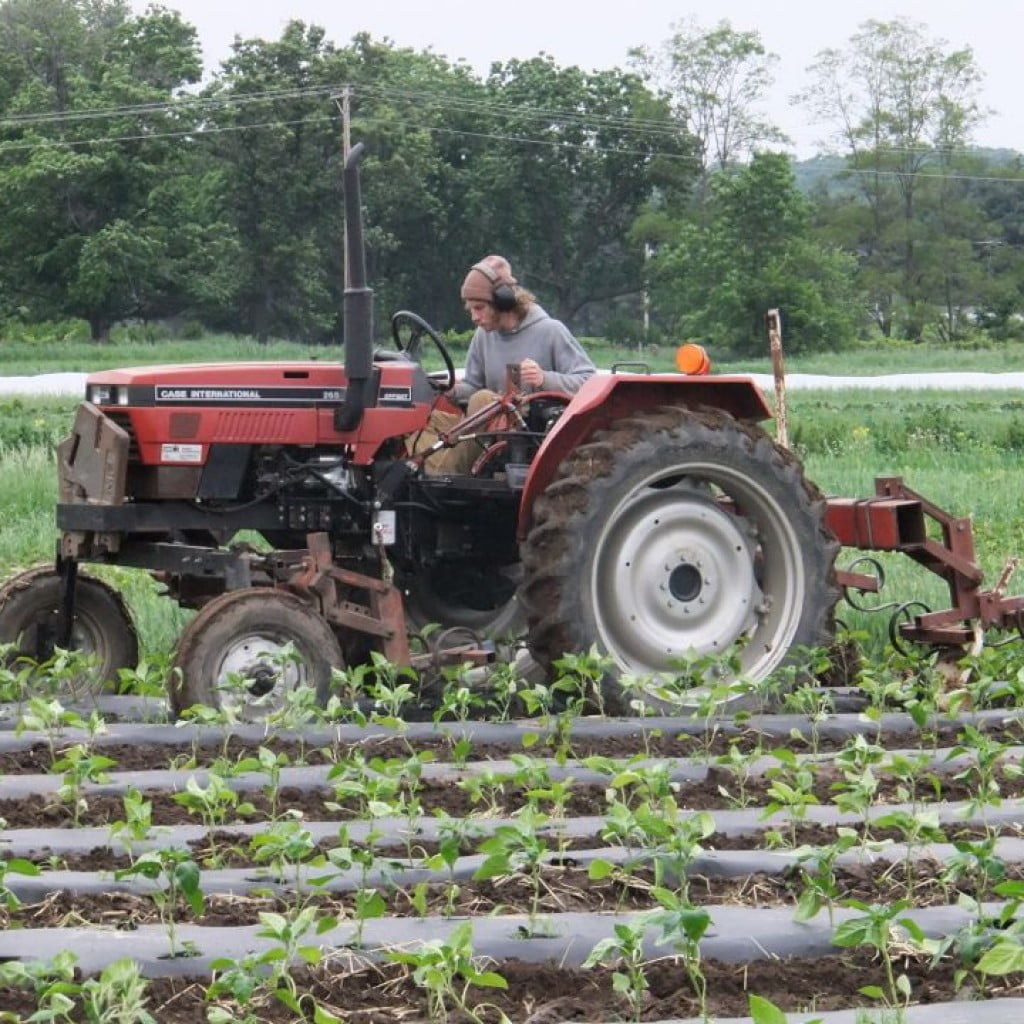
Steve is teaching Michael to cultivate. Here, he cultivates weeds at the edge of plastic mulch in our pepper fields. This job takes great concentration.
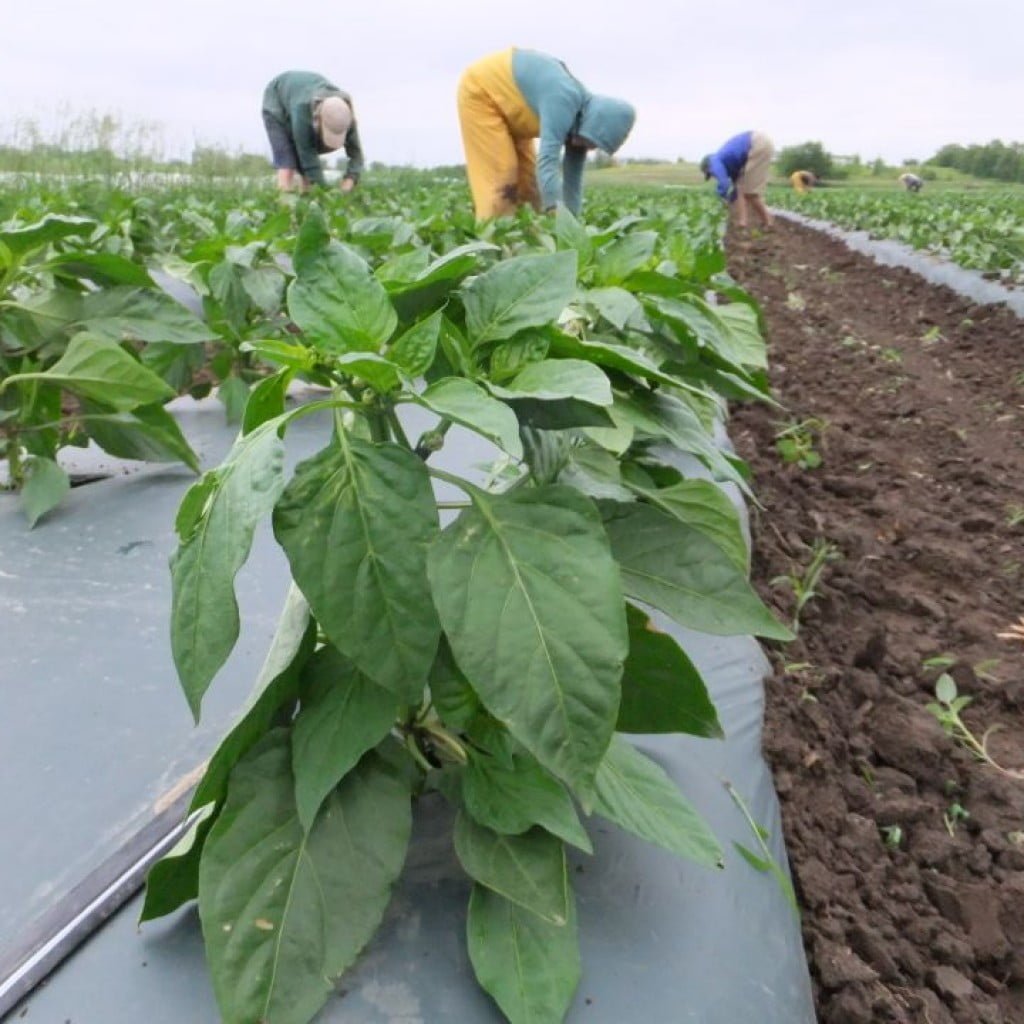
The pepper plants are thriving.
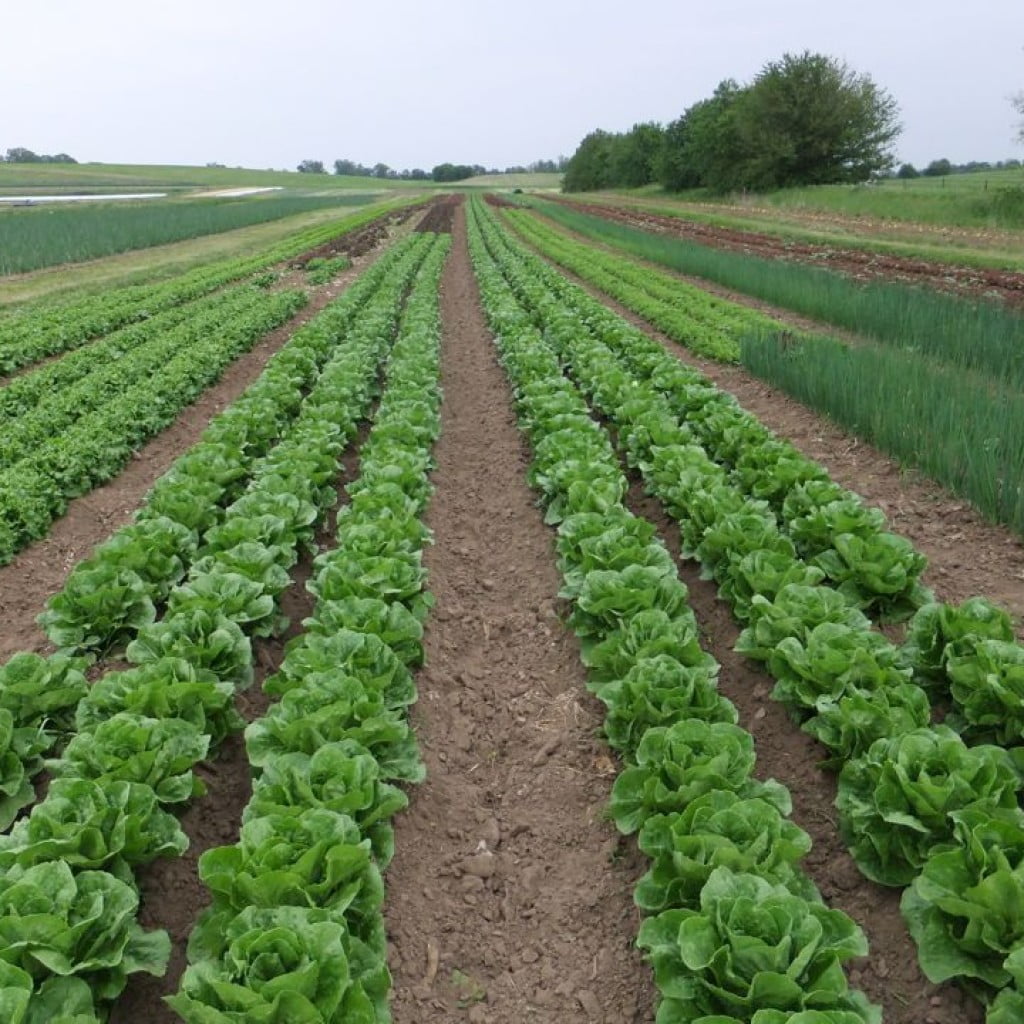
All the colors are so lovely right now. From left, endive, lettuce and scallions, ready to harvest.
A Wrinkle in Local Thyme (LT) registration
Pat wants you to know that each member’s registration will end one year after you first registered. LT has worked for some of you without renewal this year, but will lapse on the anniversary of last year’s registration. Send me an email titled “LT please” if you need the registration instructions and code.
Veggie List and Veggie Notes (6/12/14, week #4, purple EOW)
This is the year of giant spring vegetables. We’ve had great growing weather and everything is big. Quality remains excellent. Again, we encourage you to wash your produce carefully (especially asparagus, lettuce, escarole and spinach) because of the recent rains.
Asparagus, 1.3 lb
Red leaf lettuce, 1 head
Spinach, 1 large bunch, about 1.75 lb
Escarole, 1 head
White salad turnips, 1 bunch
Scallions, 1 bunch
Kohlrabi, 1
A few members will get a small head of broccoli.
Next week’s box will contain PEAS plus a few incidentals like asparagus, chard or kale, lettuce, scallions, garlic scapes, and more.
Escarole (large head of wavy green leaves) – This member of the chicory family can be eaten raw or cooked. Its slightly bitter flavor is a good addition to mixed salads. It is excellent cooked alone or mixed with other greens. It cooks quickly, but not as quickly as spinach. Refrigerate.
Kohlrabi (pale green globe with crisp white interior) – Kolrabi is an unusual vegetable that I enjoy introducing to new CSA members because almost everyone likes it. Crunchy and sweet, it’s a great addition to salads.
Storage: Kohlrabi bulbs will store for a month in the refrigerator.
Uses: Kohlrabi are good peeled and eaten out of hand, or added to sandwiches. It is good mixed into salads, or prepared as a salad on it’s own. You can grate it, slice it, or cut it into matchsticks. It’s also good cooked. If you have it, the Asparagus to Zucchini cookbook has a long list of kohlrabi suggestions.
Creative woman
- On: June 04, 2014
 0
0
Longterm Tipi farmhand Maggie Schley brought special gifts to work last week. She hauled out a suitcase during our morning meeting and presented everyone with new Tipi farm shirts she designed. She selected a special shirt for each person. Mine’s a lovely shade of green! This creative woman spins, weaves, knits, shellacs walls with onion skins, preserves tons of food, and even knit her own wedding dress. Thank you Maggie!
from left, Maggie shares new shirts with David, Steve, Kerry, Bonnie, Tristan and Michael.
Kerry (right) models Maggie’s (left) new farm shirt.
The t-shirts are printed with “Water On! Tipi Produce 2014.” Maggie’s had this design in mind for years. The phrase “water on” means a lot on our farm. It’s the first thing we say during the first outside job every spring. We use mechanical transplanters when planting our greenhouse-grown plants into the field. When the riders on the transplanter are ready for the tractor driver to move, they holler (OK, scream at the top of their lungs) “WATER ON!” It’s a sign that the water valve is open and gushing and it’s time to get moving.
From left, Larry, Maggie and Michael ride the transplanter while Kerry makes sure the seedlings are at the proper depth. The tractor pulling the transplanter is hidden to the rear. You can just see its tall roll bar.
The photo above was taken April 9, the day we transplanted the lettuce you will receive this week. Those are Romaine seedlings in the photo. Here they are now, festooned with field pennycress. No, we didn’t send the pretty weeds along with the lettuce this week.
It’s time to deposit the June 1 checks.
Many of you paid us with checks dated June 1. I will deposit the checks this Friday June 6.
Veggie List and Veggie Notes (6/5/14, week #3, GREEN EOW)
The rain was welcome this week, but splashed soil into the vegetables again. Everything needs extra washing, especially lettuce, spinach and asparagus. Dunk repeatedly in cold water until the water remains clean.
Asparagus, 1.3 lb
Spinach, 1 bunch, about 2 lb total
Romaine lettuce, 1 large
White salad turnips, 1 bunch
Mustard greens, 1 medium bunch
Green garlic, 1 small bunch
Cilantro, 1 small bunch
Next week’s box will probably contain asparagus, spinach, lettuce, white salad turnips, escarole, scallions and more.
Asparagus – Wash this asparagus well to remove grit.
Spinach – We usually tell you if the spinach is “salad-quality” or “cooking quality.” “Salad-quality” spinach is thin-leaved and tender, and shrinks substantially when cooked. “Cooking-quality” spinach is thicker-leaved and shrinks less during cooking. This week’s spinach is definitely salad-quality but we encourage you to use both ways because we are sending so much. The spinach has grown well this spring! Steam, chop and freeze any extra. You’ll be glad to have it ready to add to soups, casseroles, etc.
Romaine – Well, these are enormous. This is really nice Romaine; it was an enthusiastic grower this week. It’s time to make Caesar’s Salad.
White salad turnips – I know that returning members look forward to these sweet and delicious turnips, which taste nothing like the turnips that we harvest in fall.
– Storage: Cover and refrigerate.
– Uses: Both the turnip roots and tops are edible. Slice the sweet roots and add to salads. The roots can be cooked and are especially good when lightly sauteed in butter. Stir as little as possible so they brown on at least one side. The turnip greens are excellent cooked. Treat them like mustard greens.
– Our favorite use: Slice the roots very thinly and combine with a mixture of rice vinegar, mirin, soy sauce, sesame oil. Eat immediately or marinate.
Mustard greens – These spicy greens are so young and tender that you can use them raw in salads. They are excellent cooked until wilted, but will shrink considerably.
Green garlic – Last fall, we planted garlic cloves that grew into the stalks we’ve sent today. If left to grow until mid-summer, the slim white bulb on this week’s garlic would divide and form the usual cluster of cloves in a garlic bulb. The bunches are small this year. Remember the poor garlic crop in the Midwest last year? We could only obtain tiny heads of garlic to plant in fall. Small garlic bulbs lead to small green garlic bunches.
– Green garlic is more pungent than scallions, so slice thinly and use sparingly when raw. It mellows when cooked. Chop and add to any cooked dish that would benefit from garlic. Use the white bulbs and pale green stems. Avoid the dark green stems and leaves, as these are fibrous.
Cilantro – This herb is good in salsa, chutneys and salad dressings, or added to stir-fries. Used in Mexican, Asian and Indian cooking.
May 29 2014
- On: June 01, 2014
 0
0
No newsletter this week; the internet was spotty on Wednesday night.
Veggie List and Veggie Notes
We were glad to get rain this week, but it splashed soil into most crops. Everything needs extra washing, especially lettuce, bok choy and asparagus. See last week’s newsletter for advice on washing asparagus.
This week’s box contains:
Asparagus, 1.4 lb
Spinach, 1 large bunch, 1 to 1.25 lb
Bok choy, 1 medium head
Red bibb lettuce
Arugula, 1 bunch
Salad radishes, one bunch
Button mushrooms, 12 oz
Rhubarb, 1.5 lb
Next week’s box will probably contain asparagus, spinach, lettuce, white salad turnips, spring greens and scallions or green garlic.
Asparagus – Wash this asparagus well to remove grit.
Spinach – The spinach has grown thicker leaves since last week. It will be excellent lightly cooked, or in salads.
Bok choy – These heads have more insect damage than usual. We took the row cover off these plants so they wouldn’t get too hot and start to flower, but exposed them to flea beetles as a result. This is always the tradeoff in spring.
Red bibb lettuce – Isn’t this lettuce lovely? Bibb lettuce is very tender so handle gently.
Button mushrooms – These organic mushrooms are from Hidden Valley Mushrooms north of Madison. We buy mushrooms from Mary every year; they are a great addition to spring salads and quiches.
It’s time.
- On: May 21, 2014
 0
0
It’s time to start eating fresh food again! Our CSA deliveries begin this week for weekly members and for green every-other-week (EOW) members. Purple EOW, your first delivery is next week.
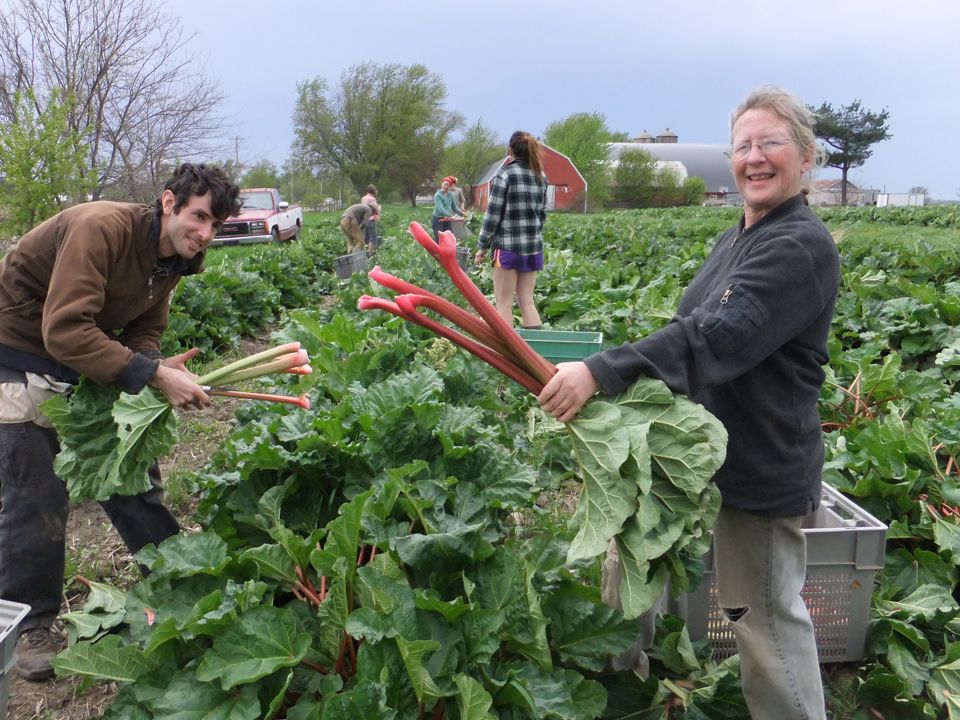
Simone, Jon and others harvest rhubarb.
Things you need to know.
♦ We post this newsletter/blog online each Wednesday night, with the list of veggies for the week, the quantities, information about storage and preparation, plus news of the farm. We’ll send an email on Wednesday night to alert you once the newsletter is ready to read.
♦ EOW and weekly members, we assume that you read all the newsletters, even on your “off” weeks. The newsletter (and our emails to you) are our means to communicate with you.
♦ The first few boxes of the season are always the lightest. EOW members, please do not worry that you have signed up for the wrong share. Our deliveries get heavier and more abundant as the season progresses.
♦ Pat Mulvey of Local Thyme will prepare menus and recipes for us again this year, but you have to register on her website for access. It’s free for Tipi CSA members. Go to www.localthyme.net/register and enter the access code that I sent in my May 2 email. If you need the code or instructions again, send me an email titled “LT please.”
Farm News
Most of our spring work involves planting for future harvests. It feels novel to harvest something!
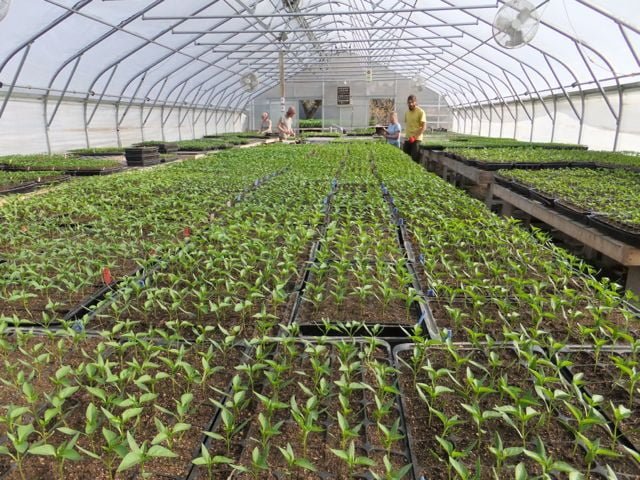
There’s always a moment when we ask ourselves if we’ve planted too many peppers. The answer is “No, you cannot have too many peppers.” The seedlings in the photo above are from our second pepper seeding. These will be large enough to transplant to the field next week.
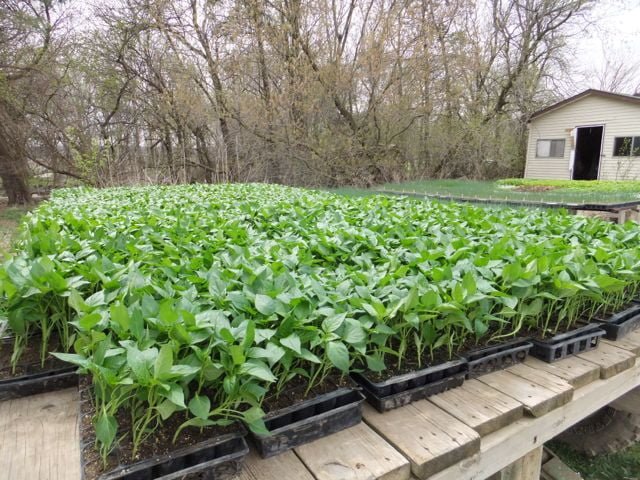
This is the first pepper planting. These babies are already out in the field and growing.
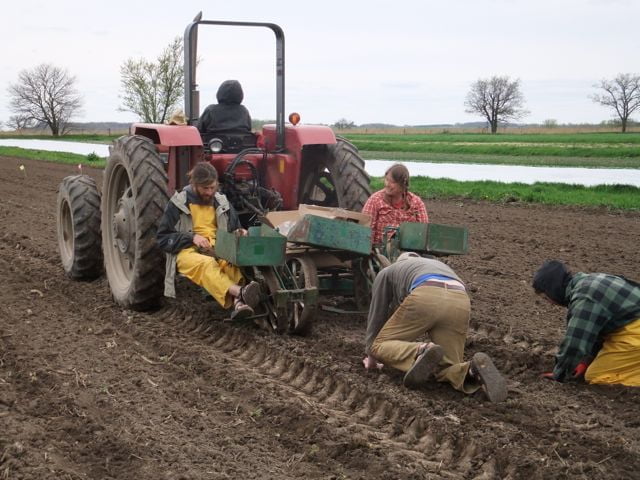
We planted next year’s strawberry field before this year’s crop even flowered. Above, Clint and Maggie ride the strawberry transplanter. Simone drives, Michael and Bonnie settle the plants.
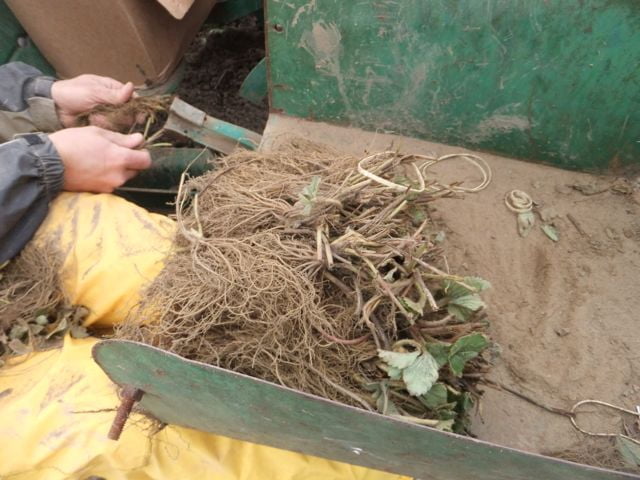
The new berry plants come to us with their tops sheared to lessen transplant shock. They perk up and start growing within a few days.
Veggie Notes (week #1, green EOW members).
We list the week’s veggies and quantities in this section, as well as information about individual vegetables. We’ll share our list of expected vegetables for the following week. I provide extra info on cooking and storage the first week that we send a vegetable. Does an item need extra washing? Does it have special qualities? This is the place to find out. For example, please, please refrigerate the potatoes. We explain the reason below.
Asparagus, 1.8 lb
Spinach, 1 to 1.25 lb
Green leaf lettuce
Arugula, one tender bunch
Salad radishes, one bunch
Goldrush russet potatoes, 3.5 lb
Rhubarb, 2 lb
Next week’s box will probably contain asparagus, spinach, lettuce, arugula, radishes, button mushrooms, bok choy and rhubarb. Maybe green garlic too.
Asparagus – Enjoy this spring treat! You will receive asparagus in a paper bag, including a small bundle tied with a rubber band. Use the rubber-banded asparagus first because it is older. Your asparagus will be green or purple. The purple variety turns dark green when cooked. Its flavor is almost identical to normal green asparagus. You must wash this asparagus thoroughly to remove hidden grit. Submerge it in water, soak briefly, then swish vigorously and pull out of the water with the tips pointing down. The draining action helps pull the grit out of the asparagus tips. Repeat several times.
Storage: Asparagus is perishable, so eat it as soon as possible. To store it, wrap the bundle in paper or cloth and store it loosely in a plastic bag. The asparagus tips tend to rot if in direct contact with the plastic bag. We snap our asparagus at harvest, rather than cutting it. Therefore, there is no need to snap the stalks to remove fibrous ends. For the same reason, it is not necessary to peel the asparagus stalks. It’s OK to trim the end a bit.
Cooking: If your asparagus stalks vary greatly in size, you will want to cook the thicker ones longer. Put the asparagus in a steamer pot over water. Alternatively, you can lay spears flat in the bottom of a broad pan, with ½ inch of water. Cover and steam over medium heat until just tender. Use two forks or a spatula to turn the asparagus during cooking, rotating the bottom spears to the top. Drain and serve. Also excellent broiled or grilled. Good dressed with vinaigrette, or simply with lime juice, salt and pepper.
Rhubarb – Refrigerate in a plastic bag. FYI, 2 lb of rhubarb yields about 6 to 6.5 cups when chopped.
Stewed rhubarb: This is the simplest way to prepare rhubarb. Chop rhubarb into one inch chunks. Stir over medium heat with a small amount of water in the bottom of the pan. The rhubarb will release moisture as it cooks. Stew until it softens and falls apart. Sweeten to taste with honey or sugar. Eat warm on its own, over vanilla ice cream, on pancakes, etc.
Goldrush russet potatoes – Please refrigerate these potatoes. They are in great shape now but will sprout within days if stored at room temperature. They’ve been stored all winter and want to grow. Store in a paper bag to protect from light, even in the fridge. We grow everything we send in our CSA boxes except potatoes, garlic and mushrooms, which we buy from organic growers that we trust. We purchased these potatoes from Jesse Perkins at Vermont Valley Farm. Jesse says the potatoes have a higher sugar content because of starch to sugar conversion during cold storage. The potatoes taste a bit sweet, and will blacken slightly when fried. It’s a harmless color change due to the sugar conversion.
Arugula – (small bunch of green leaves with pungent scent) – Arugula is good mixed with lettuce or spinach in salads, or added to cooked dishes such as lasagne or quiche. I love it on sandwiches. This arugula is thin-leaved and tender and will not store for long. Eat soon. It wilted a bit while we were harvesting it. That’s what happens when you keep it sheltered under row cover (to protect from insects), then pull off the row cover to harvest on a windy day. Cover and refrigerate.
Come meet us at these events.
- On: March 10, 2014
 0
0
There are lots of CSA-focused events this spring. Come meet us at one of these events.
March 8, 11:00 am to 3:00 pm – Local Farmer Open House in Milwaukee
Urban Ecology Center, 1500 E. Park Place, Milwaukee, WI 53211
March 16, 1:00 to 3:00 pm – Healthy Eating Fair in Stoughton (with great door prizes!)
River Bluff Middle School, 235 N Forrest Street, Stoughton, WI
Free event to meet local farmers and food producers and enjoy free refreshments from the Yahara River Grocery Cooperative. Many door prizes available including the cookbook “From Asparagus to Zucchini”, $50 gift certificates for the Yahara River Grocery Cooperative and $100 gift certificates toward a CSA farm membership.
March 22, 9:00 am to 12:00 noon – Farmers and Artisans Market in Evansville
Creekside Place, at the corner of Church St. and Maple St., Evansville , WI
March 23, 1:00 to 4:00 pm – FairShare CSA Open House in Madison
Monona Terrace, Madison, WI
This is the event to meet CSA farmers serving the greater Madison area. Workshops to de-mystify CSA, kids activities, and more.



